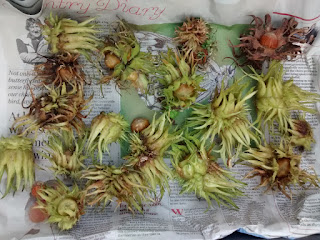At last we are about to start thinning the Scots Pine plantation. This job, which is the major task of our management plan, has taken six years for the two of us to arrange, and involved consultation and negotiation with a variety of people and agencies. The plantation dates from 1957. Much of this tree crop was blown down in the 1987 storm, and since then has remained untouched, growing both weedier and gloomier each year. If a regular thinning programme had taken place we would now have a lot more strapping big trees; instead, much of the timber is of poor quality and fit only for woodchip and biomass fuel, though there is also a fair number of large sawlog trees growing too close together. After this initial thin, the remaining timber will be left to grow on, and the thinning process carried out again in about 5 years time, and subsequently every 4 or 5 years or so until nearly all of the Scots Pine has been removed, and in its place, regenerated and/or replanted broadleaves.
To get the machinery in and out, particularly the 'artic' truck which will take the timber away, we are having to widen the new entrance, We initially thought that the old South entrance could be used if it was enlarged, but its situation prevents easy turning onto the road, and such a weight would not be tolerated on the bridges over the two neighbouring Hammerponds. Instead, our 'carpark clearing' track further up the road will be used to extract the timber from the plantation. Luckily it's in just the right spot to place the timber near the roadside for stacking and collection.
I'm not looking forward to seeing Old Copse in a mess, but this is inevitable, and as we've seen before, it quickly recovers. We'll be having plenty of bonfires this winter. The contractor will be leaving the tops 'at knee height', so we'll be clearing pathways through it for quite some time, until it eventually rots down.
Our first job was to mark the trees for extraction - easier said than done to judge which ones should go, - looks easy from a distance, but is harder when you are in among them.
.
To get the machinery in and out, particularly the 'artic' truck which will take the timber away, we are having to widen the new entrance, We initially thought that the old South entrance could be used if it was enlarged, but its situation prevents easy turning onto the road, and such a weight would not be tolerated on the bridges over the two neighbouring Hammerponds. Instead, our 'carpark clearing' track further up the road will be used to extract the timber from the plantation. Luckily it's in just the right spot to place the timber near the roadside for stacking and collection.
 |
| Felling to create a wider entrance and a timber stacking area |
 |
| The digger has arrived to widen the entrance |
Our first job was to mark the trees for extraction - easier said than done to judge which ones should go, - looks easy from a distance, but is harder when you are in among them.
.














